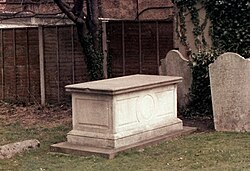Edmond Halley
Edmond Halley FRS (8 November 1656 – 25 January 1743) was an English astronomer, the second Astronomer Royal.[1]
Edmond Halley | |
|---|---|
 Portraiture by Thomas Murray, ca. 1687 | |
| Born | 8 November 1656 Haggerston, Shoreditch, London, England |
| Died | 25 January 1743 (aged 86) Greenwich, London, England |
| Nationality | British |
| Alma mater | University of Oxford |
| Known for | Halley's Comet |
| Scientific career | |
| Fields | Astronomy, mathematics, meteorology, physics |
| Institutions | University of Oxford Royal Observatory, Greenwich |

He was also a mathematician, meteorologist, and physicist. Halley is best known for computing the orbit of the comet named after him: Halley's Comet.
Career
On leaving Oxford, in 1676, Halley visited the south Atlantic island of St. Helena and set up an observatory with a 24-foot-long (7.3 m) telescope which had no tube.
He used the telescope to study stars from the Southern Hemisphere. He later published Catalogus Stellarum Australium which was about the 341 southern stars.[2]
In 1686, Halley published the second part of the results from his St. Helena expedition. This was a paper and chart on trade winds and monsoons. He thought solar heating caused atmospheric motions. He also established the relationship between barometric pressure and height above sea level. His charts were an advance in how to display information visually. Halley also persuaded Sir Isaac Newton to publish a book about his discovery of gravity.
In 1690, Halley built a diving bell, a device in which the atmosphere was replenished by way of weighted barrels of air sent down from the surface.[3] In a demonstration, Halley and five companions dived to 60 feet in the River Thames, and remained there for over an hour and a half. Halley's bell was of little use for practical salvage work, as it was very heavy, but he made improvements to it over time, later extending his underwater exposure time to over 4 hours.[4]
That same year, at a meeting of the Royal Society, Halley introduced a rudimentary working model of a magnetic compass using a liquid-filled housing to damp the swing and wobble of the magnetized needle.[5]
In 1691 Halley sought the post of Savilian Professor of Astronomy at Oxford University. As he was well known as an atheist, he was opposed by the Archbishop of Canterbury, John Tillotson. The post went instead to a mathematician who had the support of Isaac Newton.[6]
Demography
In 1693 Halley published an article on life annuities (a kind of pension), which featured an analysis of age-at-death on the basis of the Breslau statistics Caspar Neumann had been able to provide. This article allowed the British government to sell life annuities at an appropriate price based on the age of the purchaser. Halley's work strongly influenced the development of actuarial science.[7] The construction of the life-table for Breslau, which followed more primitive work by John Graunt, is now seen as a major event in the history of demography.[8]
Named after Halley
- Halley (lunar crater)
- Halley (Martian crater)
- Halley Research Station, Antarctica
- Halley's method, for the solution of many equations
- Halley Street, a street in Blackburn, Victoria, Australia
- Edmund Halley Road, Oxford Science Park, Oxford, OX4 4DQ UK
- Halley's Comet [orbital period 76 years]
- Halley Ward, surgical ward at Homerton Hospital in East London
These are generally either pronounced /ˈhæli/, rhyming with valley, or /ˈheɪli/ "Hailey", though some people will use Halley's supposed pronunciation of his own name, /ˈhɔːli/ "Hawley". The "Hailey" pronunciation inspired the rock and roll singer Bill Haley to call the rest of his band his "Comets" after Halley's Comet.[9]
Edmond Halley Media
Portrait by Richard Phillips, before 1722
Site of Halley's Observatory on the island of Saint Helena
Halley's 1701 map showing isogonic lines of equal magnetic declination in the Atlantic Ocean.
Comet-like plaque to Halley in the South Cloister of Westminster Abbey
Edmond Halley's tombstone, re-positioned at the Royal Observatory, Greenwich; he is not buried there, but at St Margaret's, Lee, some 30 minutes' walk away to the south
Halley's map of the path of the Solar eclipse of 3 May 1715 across England
References
- ↑ Although the spelling "Edmund" is quite common, "Edmond" is preferred on the basis of his own recorded usage. The Times (London) Notes and Queries #254, 8 November 1902 p36
- ↑ "Gazetteer - p7. Monuments in France - page 338". Archived from the original on 2011-07-16. Retrieved 2010-10-22.
- ↑ Edmonds, Carl; Lowry, C; Pennefather, John. "History of diving". South Pacific Underwater Medicine Society Journal. 5 (2). Archived from the original on 2010-10-14. Retrieved 2009-03-17.
{{cite journal}}: CS1 maint: multiple names: authors list (link) - ↑ "History: Edmond Halley". London Diving Chamber. Retrieved 2006-12-06.
- ↑ Gubbins, David; Herrero-Bervera, Emilio (2007). Encyclopedia of Geomagnetism and Paleomagnetism. Springer Verlag. p. 67. ISBN 978-1-4020-3992-8.
- ↑ Gjertsen, Derek (1986). The Newton Handbook. Taylor & Francis. p. 250. ISBN 978-0-7102-0279-6.
- ↑ Actuaries use maths to study the risks in the insurance and financial industries.
- ↑ Demography is the statistical study of human populations.
- ↑ "Guide Profile: Bill Haley". Archived from the original on 2012-01-21. Retrieved 2010-10-22.







